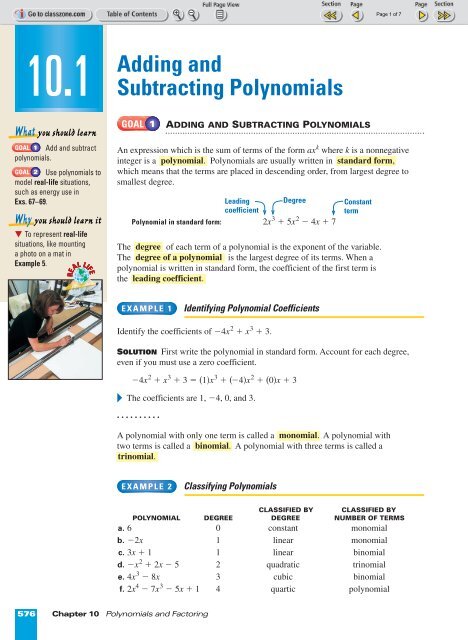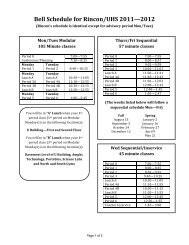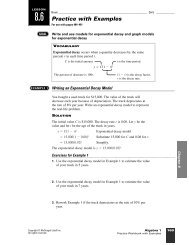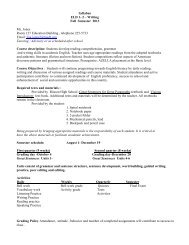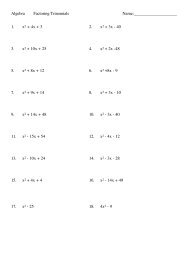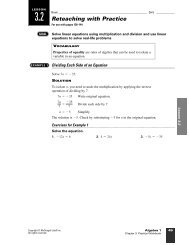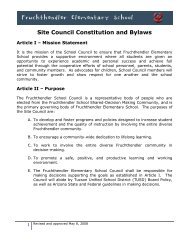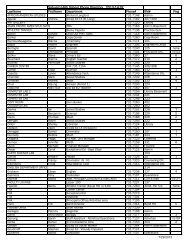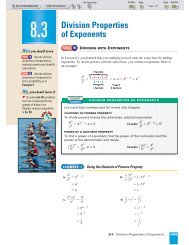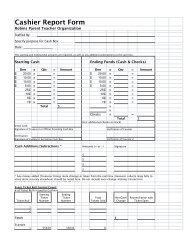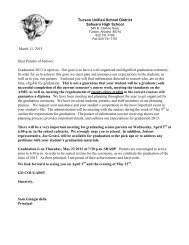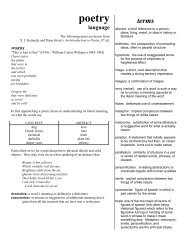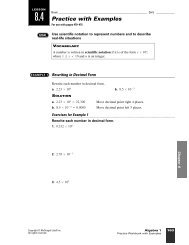Adding and Subtracting Polynomials
Adding and Subtracting Polynomials
Adding and Subtracting Polynomials
Create successful ePaper yourself
Turn your PDF publications into a flip-book with our unique Google optimized e-Paper software.
10.1<br />
<strong>Adding</strong> <strong>and</strong><br />
<strong>Subtracting</strong> <strong>Polynomials</strong><br />
What you should learn<br />
GOAL 1 Add <strong>and</strong> subtract<br />
polynomials.<br />
GOAL 2 Use polynomials to<br />
model real-life situations,<br />
such as energy use in<br />
Exs. 67–69.<br />
Why you should learn it<br />
To represent real-life<br />
situations, like mounting<br />
a photo on a mat in<br />
Example 5.<br />
REAL<br />
LIFE<br />
GOAL 1<br />
ADDING AND SUBTRACTING POLYNOMIALS<br />
An expression which is the sum of terms of the form ax k where k is a nonnegative<br />
integer is a polynomial. <strong>Polynomials</strong> are usually written in st<strong>and</strong>ard form,<br />
which means that the terms are placed in descending order, from largest degree to<br />
smallest degree.<br />
Leading Degree<br />
coefficient<br />
Polynomial in st<strong>and</strong>ard form: 2x 3 + 5x 2 º 4x + 7<br />
Constant<br />
term<br />
The degree of each term of a polynomial is the exponent of the variable.<br />
The degree of a polynomial is the largest degree of its terms. When a<br />
polynomial is written in st<strong>and</strong>ard form, the coefficient of the first term is<br />
the leading coefficient.<br />
EXAMPLE 1<br />
Identifying Polynomial Coefficients<br />
Identify the coefficients of º4x 2 + x 3 + 3.<br />
SOLUTION First write the polynomial in st<strong>and</strong>ard form. Account for each degree,<br />
even if you must use a zero coefficient.<br />
º4x 2 + x 3 + 3 = (1)x 3 + (º4)x 2 + (0)x + 3<br />
The coefficients are 1, º4, 0, <strong>and</strong> 3.<br />
. . . . . . . . . .<br />
A polynomial with only one term is called a monomial. A polynomial with<br />
two terms is called a binomial. A polynomial with three terms is called a<br />
trinomial.<br />
EXAMPLE 2<br />
Classifying <strong>Polynomials</strong><br />
CLASSIFIED BY<br />
CLASSIFIED BY<br />
POLYNOMIAL DEGREE DEGREE NUMBER OF TERMS<br />
a. 6 0 constant monomial<br />
b. º2x 1 linear monomial<br />
c. 3x + 1 1 linear binomial<br />
d. ºx 2 + 2x º 5 2 quadratic trinomial<br />
e. 4x 3 º 8x 3 cubic binomial<br />
f. 2x 4 º 7x 3 º 5x + 1 4 quartic polynomial<br />
576 Chapter 10 <strong>Polynomials</strong> <strong>and</strong> Factoring
To add or subtract two polynomials, add or subtract the like terms. You can use<br />
a vertical format or a horizontal format.<br />
STUDENT HELP<br />
EXAMPLE 3<br />
<strong>Adding</strong> <strong>Polynomials</strong><br />
HOMEWORK HELP<br />
Visit our Web site<br />
www.mcdougallittell.com<br />
for extra examples.<br />
INTERNET<br />
Find the sum. Write the answer in st<strong>and</strong>ard form.<br />
a. (5x 3 º x + 2x 2 + 7) + (3x 2 + 7 º 4x) + (4x 2 º 8 º x 3 )<br />
b. (2x 2 + x º 5) + (x + x 2 + 6)<br />
SOLUTION<br />
a. Vertical format: Write each expression in st<strong>and</strong>ard form. Align like terms.<br />
5x 3 + 2x 2 º x + 7<br />
3x 2 º4x + 7<br />
ºx 3 + 4x 2 º 8<br />
4x 3 + 9x 2 º5x + 6<br />
b. Horizontal format: Add like terms.<br />
(2x 2 + x º 5) + (x + x 2 + 6) = (2x 2 + x 2 ) + (x + x) + (º5 + 6)<br />
= 3x 2 + 2x + 1<br />
EXAMPLE 4<br />
<strong>Subtracting</strong> <strong>Polynomials</strong><br />
Find the difference.<br />
a. (º2x 3 + 5x 2 º x + 8) º (º2x 3 + 3x º 4)<br />
b. (x 2 º 8) º (7x + 4x 2 )<br />
c. (3x 2 º 5x + 3) º (2x 2 º x º 4)<br />
STUDENT HELP<br />
Study Tip<br />
A common mistake in<br />
algebra is to forget to<br />
change signs correctly<br />
when subtracting one<br />
expression from another.<br />
(x 2 º 3x) º (2x º 5x + 4)<br />
= x 2 º 3x º 2x º 5x + 4<br />
Wrong signs<br />
SOLUTION<br />
a. Use a vertical format. To subtract, you add the opposite. This means that you<br />
can multiply each term in the subtracted polynomial by º1 <strong>and</strong> add.<br />
(º2x 3 + 5x 2 º x + 8) º2x 3 + 5x 2 º x + 8<br />
º (º2x 3 + 3x º 4) Add the opposite. + 2x 3 º 3x + 4<br />
b. (x 2 º 8) x 2 º 8<br />
º (7x + 4x 2 ) Add the opposite. + º4x 2 º 7x<br />
º3x 2 º 7x º 8<br />
c. Use a horizontal format.<br />
(3x 2 º 5x + 3) º (2x 2 º x º 4) = 3x 2 º 5x + 3 º2x 2 + x + 4<br />
5x 2 º 4x + 12<br />
= (3x 2 º 2x 2 ) + (º5x + x) + (3 +4)<br />
= x 2 º 4x + 7<br />
10.1 <strong>Adding</strong> <strong>and</strong> <strong>Subtracting</strong> <strong>Polynomials</strong> 577
GOAL 2<br />
USING POLYNOMIALS IN REAL LIFE<br />
REAL<br />
LIFE<br />
EXAMPLE 5<br />
<strong>Subtracting</strong> <strong>Polynomials</strong><br />
Geometry<br />
You are enlarging a 5-inch by 7-inch photo by a scale<br />
factor of x <strong>and</strong> mounting it on a mat. You want the mat<br />
to be twice as wide as the enlarged photo <strong>and</strong> 2 inches<br />
less than twice as high as the enlarged photo.<br />
a. Draw a diagram to represent the described situation.<br />
Label the dimensions.<br />
b. Write a model for the area of the mat around<br />
the photograph as a function of the scale factor.<br />
SOLUTION<br />
a. Use rectangles to represent the mat <strong>and</strong> the photo. Use the description of the<br />
problem to label the dimensions as shown in the sample diagram below.<br />
The dimensions of the<br />
photo are enlarged by<br />
a scale factor of x.<br />
7x<br />
14x – 2<br />
The mat is 2 inches less<br />
than twice as high as<br />
the enlarged photo.<br />
5x<br />
10x<br />
The mat is twice as wide<br />
as the enlarged photo.<br />
b. Use a verbal model. Use the diagram to find expressions for the labels.<br />
PROBLEM<br />
SOLVING<br />
STRATEGY<br />
VERBAL<br />
MODEL<br />
Area of mat<br />
= Total area º<br />
Area of photo<br />
LABELS<br />
Area of mat = A<br />
Total area = (10x)(14x º 2)<br />
Area of photo = (5x)(7x)<br />
(square inches)<br />
(square inches)<br />
(square inches)<br />
ALGEBRAIC<br />
MODEL<br />
A = (10x)(14x º 2) º (5x)(7x)<br />
= 140x 2 º 20x º 35x 2<br />
= 105x 2 º 20x<br />
A model for the area of the mat around the photograph as a function of the<br />
scale factor x is A = 105x 2 º 20x.<br />
578 Chapter 10 <strong>Polynomials</strong> <strong>and</strong> Factoring
REAL<br />
LIFE<br />
Internet<br />
EXAMPLE 6<br />
<strong>Adding</strong> <strong>Polynomials</strong><br />
From 1991 through 1998, the number of commercial C <strong>and</strong> education E Internet<br />
Web sites can be modeled by the following equations, where t is the number of<br />
years since 1991. Source: Network Wizards<br />
Commercial sites (in millions): C = 0.321t 2 º 1.036t + 0.698<br />
Education sites (in millions): E = 0.099t 2 º 0.120t + 0.295<br />
Find a model for the total number S of commercial <strong>and</strong> education sites.<br />
SOLUTION<br />
You can find a model for S by adding the models for C <strong>and</strong> E.<br />
0.321t 2 º 1.036t + 0.698<br />
+ 0.099t 2 º 0.120t + 0.295<br />
0.42t 2 º 1.156t + 0.993<br />
The model for the sum is S = 0.42t 2 º 1.156t + 0.993.<br />
GUIDED PRACTICE<br />
Vocabulary Check ✓<br />
Concept Check ✓<br />
1. Is 9x 2 + 8x º 4x 3 + 3 a polynomial with a degree of 2 Explain.<br />
In Exercises 2–4, consider the polynomial expression 5x + 6 º 3x 3 º 4x 2 .<br />
2. Write the expression in st<strong>and</strong>ard form <strong>and</strong> name its terms.<br />
3. Name the coefficients of the terms. Which is the leading coefficient<br />
4. What is the degree of the polynomial<br />
ERROR ANALYSIS Describe the error shown.<br />
Skill Check ✓<br />
5. 6.<br />
7x 3 º 3x 2 + 5<br />
(4x 2 º 9x) º (º8x 2 + 3x º 7)<br />
+ 2x 3 º 5x º 7<br />
= (4x 2 + 8x 2 ) + (º9x + 3x) º 7<br />
9x 3 º 8x 2 º 2<br />
= 12x 2 º 6x º 7<br />
Classify the polynomial by degree <strong>and</strong> by the number of terms.<br />
7. º9y + 5 8. 12x 2 + 7x 9. 4w 3 º 8w + 9<br />
10. 1 2 x º 3 4 x2 11. º4.3 12. 7y + 2y 3 º y 2 + 3y 4<br />
Find the sum or the difference.<br />
13. (x 2 º 4x + 3) + (3x 2 º 3x º 5) 14. (ºx 2 + 3x º 4) º (2x 2 + x º 1)<br />
15. (º3x 2 + x + 8) º (x 2 º 8x + 4) 16. (5x 2 º 2x º 1) + (º3x 2 º 6x º 2)<br />
17. (4x 2 º 2x º 9) + (x º 7 º 5x 2 ) 18. (2x º 3 + 7x 2 ) º (3 º 9x 2 º 2x)<br />
10.1 <strong>Adding</strong> <strong>and</strong> <strong>Subtracting</strong> <strong>Polynomials</strong> 579
PRACTICE AND APPLICATIONS<br />
STUDENT HELP<br />
Extra Practice<br />
to help you master<br />
skills is on p. 806.<br />
CLASSIFYING POLYNOMIALS Identify the leading coefficient, <strong>and</strong> classify<br />
the polynomial by degree <strong>and</strong> by number of terms.<br />
19. º3w + 7 20. º4x 2 + 2x º 1 21. 8 + 5t 2 º 3t + t 3<br />
22. 8 + 5y 2 º 3y 23. º6 24. 14w 4 + 9w 2<br />
25. º 2 3 x + 5x4 º 5 6 26. º4.1b2 + 7.4b 3 27. º9t 2 + 3t 3 º 4t 4 º 15<br />
28. 9y 3 º 5y 2 + 4y º 1 29. º16x 3 30. º8z 2 + 74 + 39z º 95z 4<br />
VERTICAL FORMAT Use a vertical format to add or subtract.<br />
31. (12x 3 + 10) º (18x 3 º 3x 2 + 6) 32. (a + 3a 2 + 2a 3 ) º (a 4 º a 3 )<br />
33. (2m º 8m 2 º 3) + (m 2 + 5m) 34. (8y 2 + 2) + (5 º 3y 2 )<br />
35. (3x 2 + 7x º 6) º (3x 2 + 7x) 36. (4x 2 º 7x + 2) + (ºx 2 + x º 2)<br />
37. (8y 3 + 4y 2 + 3y º 7) + (2y 2 º 6y + 4)<br />
38. (7x 4 º x 2 + 3x) º (x 3 + 6x 2 º 2x + 9)<br />
HORIZONTAL FORMAT Use a horizontal format to add or subtract.<br />
39. (x 2 º 7) + (2x 2 + 2) 40. (º3a 2 + 5) + (ºa 2 + 4a º 6)<br />
41. (x 3 + x 2 + 1) º x 2 42. 12 º (y 3 + 4)<br />
43. (3n 3 + 2n º 7) º (n 3 º n º 2) 44. (3a 3 º 4a 2 + 3) º (a 3 + 3a 2 º a º 4)<br />
45. (6b 4 º 3b 3 º 7b 2 + 9b + 3) + (4b 4 º 6b 2 + 11b º 7)<br />
46. (x 3 º 6x) º (2x 3 + 9) º (4x 2 + x 3 )<br />
POLYNOMIAL ADDITION AND SUBTRACTION Use a vertical format or a<br />
horizontal format to add or subtract.<br />
47. (9x 3 + 12) + (16x 3 º 4x + 2) 48. (º2t 4 + 6t 2 + 5) º (º2t 4 + 5t 2 + 1)<br />
49. (3x + 2x 2 º 4) º (x 2 + x º 6) 50. (u 3 º u) º (u 2 + 5)<br />
51. (º7x 2 + 12) º (6 º 4x 2 ) 52. (10x 3 + 2x 2 º 11) + (9x 2 + 2x º 1)<br />
53. (º9z 3 º 3z) + (13z º 8z 2 ) 54. (21t 4 º 3t 2 + 43) º (19t 3 + 33t º 58)<br />
55. (6t 2 º 19t) º (3 º 2t 2 ) º (8t 2 º 5)<br />
56. (7y 2 + 15y) + (5 º 15y + y 2 ) + (24 º 17y 2 )<br />
57.x 4 º 1 2 x2 + x 3 + 1 3 x2 + 1 4 x2 º 9<br />
STUDENT HELP<br />
HOMEWORK HELP<br />
Example 1: Exs. 19–30<br />
Example 2: Exs. 19–30<br />
Example 3: Exs. 31–62<br />
Example 4: Exs. 31–62<br />
Example 5: Exs. 63, 64<br />
Example 6: Exs. 65–69<br />
58. (10w 3 + 20w 2 º 55w + 60) + (º25w 2 + 15w º 10) + (º5w 2 + 10w º 20)<br />
59. (9x 4 º x 2 + 7x) + (x 3 º 6x 2 + 2x º 9) º (4x 3 + 3x + 8)<br />
60. (6.2b 4 º 3.1b + 8.5) + (º4.7 + 5.8b 2 º 2.4b 4 )<br />
61. (º3.8y 3 + 6.9y 2 º y + 6.3) º (º3.1y 3 + 2.9y º 4.1)<br />
62. 2 5 a4 3<br />
º 2a + 7 º º a 1 0<br />
4 + 6a 3 º (2a 2 º 7)<br />
580 Chapter 10 <strong>Polynomials</strong> <strong>and</strong> Factoring
BUILDING A HOUSE In Exercises 63 <strong>and</strong> 64, you plan to build a house<br />
that is 1} 1 2 } times as long as it is wide. You want the l<strong>and</strong> around the house<br />
to be 20 feet wider than the width of the house, <strong>and</strong> twice as long as the<br />
length of the house, as shown at the right.<br />
63. Write an expression for the<br />
area of the l<strong>and</strong> surrounding<br />
the house.<br />
64. If x = 30 feet, what is the<br />
area of the house What is<br />
the area of the entire property<br />
1.5x<br />
x<br />
x + 20<br />
POPULATION In Exercises 65 <strong>and</strong> 66, use the following information.<br />
Projected from 1950 through 2010, the total population P <strong>and</strong> the male<br />
population M of the United States (in thous<strong>and</strong>s) can be modeled by the<br />
following equations, where t is the number of years since 1950.<br />
INTERNET<br />
DATA UPDATE of U.S. Bureau of the Census data at www.mcdougallittell.com<br />
Total population model: P = 2387.74t + 155,211.46<br />
Male population model: M= 1164.16t + 75,622.43<br />
65. Find a model that represents the female population F of the United States<br />
from 1950 through 2010.<br />
66. For the year 2010, the value of P is 298,475.86 <strong>and</strong> the value of M is<br />
145,472.03. Use these figures to predict the female population in 2010.<br />
3x<br />
FOCUS ON<br />
CAREERS<br />
ENERGY USE In Exercises 67–69, use the following information.<br />
From 1989 through 1993, the amounts (in billions of dollars) spent on natural gas<br />
N <strong>and</strong> electricity E by United States residents can be modeled by the following<br />
equations, where t is the number of years since 1989.<br />
Source: U.S. Energy Information Administration<br />
Gas spending model: N = 1.488t 2 º 3.403t + 65.590<br />
Electricity spending model: E = º0.107t 2 + 6.897t + 169.735<br />
ELECTRICAL<br />
ENGINEERS<br />
design, test, <strong>and</strong> monitor the<br />
performance of electrical<br />
equipment. This includes<br />
equipment used by power<br />
utilities to generate <strong>and</strong><br />
transmit electricity.<br />
CAREER LINK<br />
www.mcdougallittell.com<br />
REAL<br />
INTERNET<br />
LIFE<br />
67. Find a model for the total amount<br />
A (in billions of dollars) spent on<br />
natural gas <strong>and</strong> electricity by<br />
United States residents from 1989<br />
through 1993.<br />
68. According to the models, will<br />
more money be spent on natural<br />
gas or on electricity in 2020<br />
69. The graph at the right shows U.S.<br />
energy spending starting in 1989.<br />
Models N, E, <strong>and</strong> A are shown.<br />
Copy the graph <strong>and</strong> label the<br />
models N, E, <strong>and</strong> A.<br />
Amount spent (billions of dollars)<br />
Energy Spending<br />
Electricity<br />
350<br />
Gas<br />
300<br />
250<br />
200<br />
150<br />
100<br />
50<br />
0<br />
0 2 4 6<br />
Years since 1989<br />
8<br />
t<br />
10.1 <strong>Adding</strong> <strong>and</strong> <strong>Subtracting</strong> <strong>Polynomials</strong> 581
Test<br />
Preparation<br />
70. MULTI-STEP PROBLEM The table below shows the amounts that Megan <strong>and</strong><br />
Sara plan to deposit in their savings accounts to buy a used car. Their savings<br />
accounts have the same annual growth rate g.<br />
Date 1/1/00 1/1/01 1/1/02 1/1/03<br />
Megan $250 $400 $170 $625<br />
Sara $475 $50 $300 $540<br />
★ Challenge<br />
EXTRA CHALLENGE<br />
www.mcdougallittell.com<br />
a. On January 1, 2003, the value of Megan’s account M can be modeled by<br />
M = 250g 3 + 400g 2 + 170g + 625, where g is the annual growth rate.<br />
Find a model for the value of Sara’s account S on January 1, 2003.<br />
b. Find a model for the total value of Megan’s <strong>and</strong> Sara’s accounts together<br />
on January 1, 2003.<br />
c. The annual growth rate g is equal to 1 + r, where r is the annual interest<br />
rate. The annual interest rate on both accounts is 2.5% for the three-year<br />
period. Find the combined value of the two accounts on January 1, 2003.<br />
d. If the used car that Megan <strong>and</strong> Sara want to buy costs $2500, will they<br />
have enough money<br />
71. The sum of any two consecutive integers can be written as (x) + (x + 1).<br />
Show that the sum of any two consecutive integers is always odd.<br />
72. Use algebra to show that the sum of any four consecutive integers is<br />
always even.<br />
MIXED REVIEW<br />
DISTRIBUTIVE PROPERTY Simplify the expression. (Review 2.6 for 10.2)<br />
73. º3(x + 1) º 2 74. (2x º 1)(2) + x 75. 11x + 3(8 º x)<br />
76. (5x º 1)(º3) + 6 77. º4(1 º x) + 7 78. º12x º 5(11 º x)<br />
79. BEST-FITTING LINES Draw a scatter plot. Then draw a line that<br />
approximates the data <strong>and</strong> write an equation of the line. (Review 5.4)<br />
(º7, 19), (º6, 16), (º5, 12), (º2, 12), (º2, 9), (0, 7),<br />
(2, 4), (6, º3), (6, 2), (9, º4), (9, º7), (12, º10)<br />
EXPONENTIAL EXPRESSIONS In Exercises 80º85, simplify. Then use a<br />
calculator to evaluate the expression. Round the result to two decimal<br />
places when appropriate. (Review 8.1)<br />
80. (4 • 3 2 • 2 3 ) 4 81. (2 4 • 2 4 ) 2 82. (º6 • 3 4 ) 3<br />
83. (1.1 • 3.3) 3 84. 5.5 3 • 5.5 4 85. (2.9 3 ) 5<br />
86. ALABAMA The population P of Alabama (in thous<strong>and</strong>s) for 1995<br />
projected through 2025 can be modeled by P = 4227(1.0104) t , where t is the<br />
number of years since 1995. Find the ratio of the population in 2025 to the<br />
population in 2000. Compare this ratio with the ratio of the population in<br />
2000 to the population in 1995. Source: U.S. Bureau of the Census (Review 8.3)<br />
582 Chapter 10 <strong>Polynomials</strong> <strong>and</strong> Factoring


